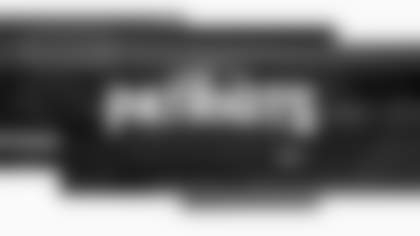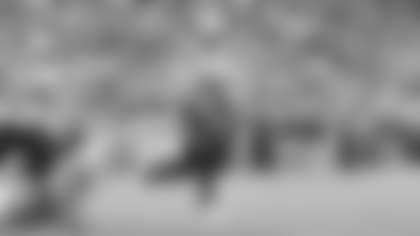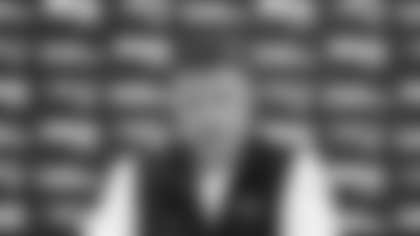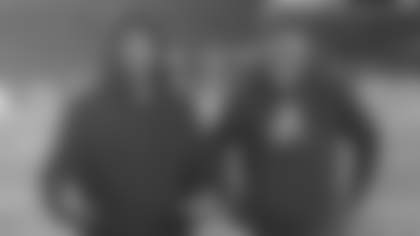At this point, the opening section to After Further Review is becoming a weekly autopsy of the Patriots offense and where things stand for this team at the quarterback position.
Quarterbacks are lightning rods when things are going poorly, while they're often the first credited with when the team is winning. That's the nature of the position. Although we typically subscribe to the theory that wins aren't exclusively a QB stat, there are certain instances where you say to yourself, "To be a starting quarterback in the NFL, you need to win that game."
For Patriots quarterback Mac Jones, Sunday's rock fight with the Colts in Frankfurt was one of those games. No, it's not on Jones that the offensive line allowed a 44.4% pressure rate, including five first-half sacks that were mostly on his pass protection. Nor can the quarterback throw and catch the ball, but let's admit the following into evidence. First, courtesy of Boston Sports Info, teams had won 266 consecutive NFL games when they rushed for at least 150 yards (Pats ran for 167) and held opponents to ten points or less (Indy scored ten).
On Sunday, the Patriots outgained the Colts (340 to 264), had seven more first downs (21 to 14), were better on third down (43% to 38%), and made four trips inside the red zone to Indy's one. The Pats had their opportunities in this game to put points on the board but couldn't, becoming the first team in over a decade to lose with 150-plus rush yards and ten points or fewer allowed. The last loss under those parameters? Tim Tebow's Broncos lost 7-3 to the Chiefs in Week 17, 2012 – Tebow completed just six passes on a cold January afternoon.
If the recipe for a victory was to score into the 20s with this pass protection, we'd give Jones a pass. These were tough working conditions for a pocket quarterback, who was under duress from the very first drop-back and didn't have many quick answers to stay poised. However, all they needed was one go-ahead touchdown drive to outduel Colts backup quarterback Gardner Minshew, who was primarily responsible for the Colts ineptitude on offense. Jones had his chances. Let's break them down in order:
THIRD-AND-3, IND 17 (3RD QTR, 8:50): M. JONES PASS INCOMPLETE TO R. STEVENSON
"Teapot" O'Brien made an appearance on the sideline following this near-disaster. The Pats are running a staple concept in their offense where a shallow crosser is an influencer to the second level. It appears that Jones is waiting for rookie Demario Douglas's drag route to pull the middle linebacker in a zone drop out of the passing lane to TE Hunter Henry. Although it eventually comes open as the pressure arrives, Mac has a dump-off to RB Rhamondre Stevenson in the left flat, a potential touchdown to JuJu Smith-Schuster (bottom), or he could've put it on Douglas quickly to pick up the first down. Instead, he gets stuck on Henry, drops his eyes to the rush, and makes an ill-advised late flip to Stevenson.
THIRD-AND-5, IND 5 (4TH QTR, 12:52): M. JONES PASS INCOMPLETE TO H. HENRY
Next, the Patriots got the ball down to the Colt's five-yard line in the fourth quarter. This time, it's a simple leverage read for Jones with an off-man defender shaded inside Henry and Douglas's route occupying the boundary corner. Jones makes the right decision to throw to his favorite red-zone target, but it's an early ball with far too much air under well behind the receiver that is nearly intercepted. This throw should've been more on a line where Henry can box out the defender. It should be six.
2ND-AND-12, IND 15 (4TH QTR, 4:25): M. JONES PASS INTENDED FOR M. GESICKI INTERCEPTED BY J. BLACKMON AT IND 1
Lastly, the play that got Jones benched was the most egregious miss. With the Patriots effectively running the ball downhill at the Colts, O'Brien dials up gun action with a pulling guard to mimic a trap scheme. The run action goes perfectly into the safety rotation, allowing TE Mike Gesicki's crosser to get behind the defense for an easy score. Unfortunately, we all know how this play ended, landing Jones on the bench for the game's final drive.
If the Patriots needed to win a shootout on Sunday, we'd have Jones's back, as we have many times throughout his career. There might not be a quarterback, past or present, who could've had an overly productive offensive day under these same circumstances. Most of the blame still lies with head coach Bill Belichick, who took a functional starter as a rookie and played the hits on stunting his development from a coaching and personnel standpoint.
But the results on film are what they are at this point for Jones, justifying a permanent benching in favor of backup Bailey Zappe or third-string QB Will Grier coming off the bye week against the Giants. From this perspective, New England will be in the quarterback market in 2024.
Here are two more big-picture takeaways and quick-hit film notes from the Patriots loss to the Colts in Frankfurt After Further Review:
1. Run Game Explodes for Season-High 167 Yards, But Play-Action Still Uneffective
The silver lining offensively was a breakout performance for running back duo Rhamondre Stevenson and Ezekiel Elliott, who contributed to a season-high 167 rushing yards on Sunday.
New England generated +0.08 expected points added per rush with a 57 percent rushing success rate, which rises above the 82nd percentile in those metrics. A bulk of the credit goes to the Pats offensive line. The two backs only gained +7 rushing yards over expected, meaning the O-Line was putting in work, while the Pats back also forced six missed tackles with 93 yards after contact.
The Patriots got a great run blocking from the offensive line and the two running backs in Sunday's loss, with the Pats favorite gap scheme "duo" being the top call. Pats OC Bill O'Brien also mixed in wham schemes, outside zone, inside zone, draws, and trap plays. But the flashy runs mostly came on duo, where the offense looks to move the line of scrimmage with interior double-teams that will eventually release to the second level once they get rolling downhill.
As you can see above, the Pats ran duo several times behind rookie right guard Sidy Sow and right tackle Michael Onwenu. Those two were bulldozers on the right side, forming double teams that reset the line of scrimmage throughout the game.
However, the problem with successfully running the ball for small chunks at a time is that it doesn't necessarily lead to points. The Pats had a successful day on the ground but only scored six points, so what gives? Why wasn't the offense as a whole more productive?
The answer is their inability to marry their run-game success with explosive plays off play-action. Mac Jones's interception should've been a big touchdown off play-action, but there were other issues with the run-play action sequencing. On seven play-action attempts, the Pats only generated 32 yards (6.4 average) along with the iNT.
To his credit, O'Brien did a nice job of marrying the plays together from a schematic standpoint. Here is the Pats first play from scrimmage on Sunday. Knowing the Colts are a zone-heavy defense, O'Brien puts Douglas in motion at the snap to get the linebacker level to bump over. Then, and this is an important detail, tight end Mike Gesicki loops inside Pharaoh Brown to insert up to the safety while Brown kicks out the edge defender to allow for the double team.
Although the run only gained three yards, it was supposed to serve as window dressing for a game-planned play-action pass. Later in the drive, the Pats show all the same details with Douglas's motion, Gesicki and Brown exchanging gaps, and duo blocking on the interior. Unfortunately, Gesicki trips on a Colts defender as he runs through the line of scrimmage, Douglas probably could've gotten his head around faster on the wheel route, and Jones needs to sell the fake better to get the linebackers to bite on the run action.
After setting all that up earlier in the drive, the completion to Stevenson gains a whopping two yards, which says everything about this offense. Nothing comes easy to this group. The run game alone isn't enough to put up points, making the play-action off the run game essential.
The Patriots had one of their best rushing performances of the season on Sunday, but the offense needs to improve its play-action effectiveness to hit defenses where it hurts the most.
2. Pass Defense Still Having Similar Issues as Loss to Commanders, Colts Offense to Blame?
We wanted to come away from watching the Patriots defense film with a glowing review about how they shut down the Colts offense in one of their better performances this season.
New England's run defense did come to play. The Pats held the sixth-ranked rush DVOA offense to -0.13 expected points added per rush and a 36% success rate (above average). Two years ago, former All-Pro Jonathan Taylor ran all over the Patriots. This time, Taylor only managed 69 yards on 23 carries (3.0 average) with a rushing long of only 10 yards.
The Patriots stuck with their two-gapping front mechanics to effectively build a wall on Taylor and mostly handled the Eagles-like option designs well (there were some iffy reads on RPO schemes by Minshew. Sorry, just being honest). Still, the Pats had 14 run stuffs, and we'd give high marks to Davon Godchaux (3 stuffs), Christian Barmore (3 stuffs), Anfernee Jennings (four stuffs), and Lawrence Guy (stuff). Plus, they stopped the run without LB Ja'Whaun Bentley.
Although it was a good performance against a top rushing attack, the pass defense still had many of the same issues it did vs. the Commanders last week. There were coverage busts, and the most worrisome aspect is that the third-down pass rush is struggling. Whether it's a four-man rush, five-plus rushers, creepers, or simulated pressure, New England isn't getting home with its pass rush consistently enough to win on high-leverage downs.
For example, here is a back-breaking third down conversion on a 28-yard completion to rookie wide receiver Josh Downs. The Pats are running a one-cross coverage where Myles Bryant passes off Down's initial crossing route to Jalen Mills in the middle of the man structure. They have good initial coverage on the play, but even with the center having to respect LB Jahlani Tavai as a blitzing threat, the four-man rush can't get off any blocks, giving Minshew all day. Eventually, Downs breaks into an open space where Minshew finds him for a deep completion.
By getting a new set of downs there with 2:52 remaining, the Pats had to use all three of their timeouts to get the ball back after the two-minute warning (1:52). Most importantly, the Colts flipped the field, going from their own ten yard-line to pinning New England at their 14-yard line. For a struggling offense, starting the drive on a shorter field is critical in that situation.
Along with their standard four-man rushes falling flat, opposing offenses seem to have the Patriots creepers pressures figured out. Creepers are when an expected blitzer drops into coverage to replace a typical coverage player who adds to the rush. Rather than a traditional blitz where the defense brings more rushers than blockers, it's still a four-man rush with a twist.
This time, edge defender Anfernee Jennings drops off the line of scrimmage to replace Mack Wilson in the zone coverage structure as Wilson blitzes up the middle. But the right guard and center close the A-Gap before Wilson's blitz gets through the line of scrimmage, and Minshew once again has plenty of time to extend the play for another third-down conversion.
Lastly, in the coverage bust category, the Patriots were lucky they didn't give up an explosive here. Although it's impossible to know for sure, it appears that this is man coverage with a single-high safety (man-free). However, Jalen Mills plays it like zone, and a catchable ball goes off tight end Kylen Granson's hands on what should've been a huge gain for Indianapolis.
Ultimately, it's tough to blame the Patriots defense for the loss when they only allowed ten points, and the offense is clearly their biggest problem. However, the defense is still not playing at a high level either, with assignment issues and ineffectiveness on critical third downs.
3. Quick-Hit Film Notes From Patriots-Colts in Deutschland
- The lack of quickness at receiver and not having a pure pass-catching back is killing this offense. The Pats need receivers who can deliver quick wins on their routes, especially when the O-Line is playing like this. Pop Douglas might be the future in the slot, but they don't seem to trust him on option routes yet, leaving Hunter Henry to run return/whips on third down (result: sack). Rhamondre has improved his timing out of the backfield, but the separation at the top of the route is inconsistent (12:31 1st QTR). They don't have a chain-mover/security blanket.
- Backup QB Bailey Zappe made two strong throws to Henry and Douglas on third down, but that fake spike INT was brutal. Horrible. He should've just checked it down to Gesicki in the flat and moved on to the next play. Zappe has better feet and subtle movements in the pocket than Mac Jones. But he misses some layups (off-target slant to Pop), and his decision-making can't give the coaches much trust in him.
- Watching live, it felt like the Patriots weren't prepared to handle Indy's pressure package and D-Line movement. Two of the five sacks were on schemed rushes, but most pressures came from losing one-on-one, which is more troubling. This was Cowboys/Saints levels of pressure (44.4%). QB pressures allowed: Sow (sack, 4), Strange (sack, 4), Andrews (sack, 2), Stevenson (sack), McDermott (2), Lowe (1), Onwenu (1).
- RB Rhamondre Stevenson has returned to his 2022 form over the last three weeks. Stevenson ranks second in rushing yards after contact (169) and fifth in rushing yards over expectation (+62) since Week 8. With more space available, Stevenson is hitting the slalom course again with his lateral cuts, breaking tackles (eight in the last three games), and is getting downhill to finish with power. O'Brien needs to feed him the rock early and often, with Zeke as a capable spell back when needed.
- LG Cole Strange must see Colts DT DeForest Buckner in his nightmares. I try to evaluate Strange objectively and separately from my opinions of the draft pick itself, which are well-documented. Besides when he gets out in space in the run/screen game, there's not enough there to project him as a long-term starter. Strange's build is too linear/narrow for the interior, so he tries to fight fire with fire by being aggressive in his pass sets. A savvy IDL can see that on film, so guys like Buckner use arm-overs to swim around him or immediately cross his face at the snap. His balance and ability to anchor is a major issue for his long-term projection. If/when David Andrews retires, I wonder if they will try Strange at center.
- RG Sidy Sow had his worst game in pass protection since taking over as a starter in Week 6. The biggest issue with Sow's pass sets is his hand technique. He plays with wide, predictable punches that often give up his chest, making it difficult for him to latch on to rushers challenging his edges. The footwork and size/power are there, but he has to become a better hand fighter to be more consistent. Sow was solid as a run-blocker, though, with some tremendous combos/doubles working alongside Onwenu that were fun to watch.
- RT Mike Onwenu was their most effective lineman again. His depth in his kick slides can be inconsistent as he works on tackle footwork, which lead to one hurry that eventually was a sack. But that was Onwenu's lone pressure of the day, while he was excellent in the running game for the second week in a row. I'm sold on re-signing him as their permanent right tackle.
- C David Andrews was late to ID two stunts that led to a sack and a hurry. He eventually caught the looper on the sack but couldn't drop his anchor in time to maintain the pocket. He continues to excel as a run-blocker. Andrews is the least of their worries, and my guess is the two Ls in pass pro were because he's putting a lot on himself to help the two young guards.
- LT Conor McDermott is a fine spot-starter. His losses in pass pro can be ugly, mostly guys beating him to the edge or crossing his face quickly, causing him to move his feet suddenly. But he gets in the way often enough and can block the backside on their downhill runs.
- WR JuJu Smith-Schuster had more penalties (2) than catches (1) in this game, which says it all. There were a few missed opportunities for Smith-Schuster, mainly on the 3rd QTR play that got Mac chewed out by O'Brien. With more trust in the pocket, Smith-Schuster had a touchdown on a fade route with Henry occupying the deep safety. JuJu runs to the right areas to be schemed open, but he doesn't have the juice to create his own separation.
- Pop Douglas is both their best receiver and his own worst enemy. My guess is the coaches don't trust him to run the option series because he's not converting routes properly in practice, so all his routes are locked when they really need him running the juke series out of the slot a la Welker/Edelman. He ran away easily from Kenny Moore on his explosive, and is a weapon screens, but the route-running inconsistencies hurt how much they can feed him.
- WR Kayshon Boutte can run in-breaking routes well enough to have a role in this offense. He creates separation on slants and digs while using his stouter frame to keep defenders on his back. But those throws take trust/anticipation, which you couldn't possibly expect the QB to have in him when the coaches don't even put him on the field. I want to see more.
- DT Christian Barmore continues his hot streak with two QB pressures (one QB hit) and three run stops. Barmore's TFL came on a sweet inside move to backdoor a zone scheme on Quenton Nelson, while his power rush/hump move delivered twice in the pass rush. We are on a run of five straight elite football games from Barmore now.
- LB Jahlani Tavai was really good in this one. He had a hurry on a well-executed twist, made a stop, and that was a very athletic play to tip Minshew's pass on Bryant's interception. Tavai has been playing like an above-average starter this season. Has come into his own.
- DT Lawrence Guy was one of their better players in this game. His ability to absorb contact, anticipate blocks, and hold the point of attack is still NFL caliber at nearly 34 years old.
- Rookie Keion White has some really good moments where his power flashes, and his recovery talent is very noticeable. He is their best rusher at closing on quarterbacks who try to leave the pocket. They need him to develop a rush plan and a wider variety of pass-rush moves.
- The numbers don't exactly show it (5 catches, 30 yards on six targets), but Shaun Wade was serviceable. He stayed connected to vertical routes, blew up a screen for a five-yard TFL, and was more consistent with his technique at the top of routes. He's getting better on the outside.
- This defense isn't improving this season unless Josh Uche (two hurries) and Kyle Dugger (one impactful play/TFL) return to being playmakers. Uche is all speed-to-power right now. Where did the toolbox of moves/counters go? Is he too worried about keeping the QB in the pocket? Dugger was as passive as I've seen him against the run.
- The special teams miscues reach new lows every week. The Colts didn't flinch at the Patriots punt block attempt, and the 41-yard return was too easy. The issues in this phase are ridiculous, given how much this team invests in the kicking game overall.
- QB pressures: Barmore (2), White (2), Wilson (2), Uche (2), Tavai (1), Wise (1), Peppers (1), Guy (1).
- Coverage: Bryant (4/4/50 yards, INT), Wade (6/5/30 yards), Jack Jones (2/2/30 yards), Mills (3/1/28 yards), Jon Jones (3/2/24 yards), Jennings (2/2/19 yards), Munson (1/1/7 yards, Tavai (3/1/6 yards, PBU).
DISCLAIMER: The views and thoughts expressed in this article are those of the writer and don't necessarily reflect those of the organization. Read Full Disclaimer














































